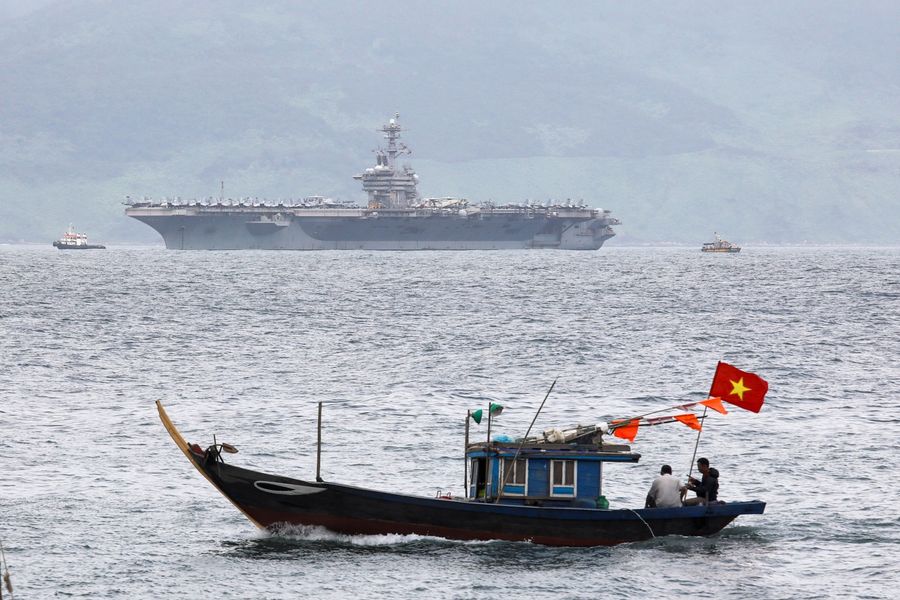US aircraft carrier visit and Vietnam's delicate balancing act

The rise of China has been the single most consequential development for global geopolitics over the past three decades, triggering both hopes and fears. As an immediate neighbour of China, Vietnam was among the first to both benefit from China's increasing prosperity and to feel the impact from China's growing weight. Consequently, while trying to maintain a stable and peaceful relationship with China to facilitate economic cooperation, Hanoi also strengthens defence ties with the US and other powers to deal with the China threat, especially in the South China Sea.
Vietnam finds no other power more compatible to work with than the US.
China is currently Vietnam's largest trade partner, and also its largest source of imports. According to the General Statistics Office of Vietnam, the two countries' two-way trade turnover in 2018 reached US$106.94 billion, accounting for 22.2% of Vietnam's total trade turnover in the same year. At the same time, China is becoming an increasingly important foreign investor of Vietnam. By the end of 2018, China had become Vietnam's 7th largest foreign investor with 2,168 projects and US$13.4 billion in accumulative registered capital. If Hong Kong was included, China would rank number four, only after South Korea, Japan and Singapore. China is also the most important source of tourist arrivals for Vietnam. In 2018, for example, 4,966,500 Chinese tourists visited Vietnam, accounting for 32% of Vietnam's foreign tourist arrivals in the same year.

The strong economic ties mean that it is in Vietnam's interest to maintain a healthy and stable relationship with China. However, the South China Sea dispute has put incessant constraints on bilateral ties, forcing Vietnam to adopt a confrontational stance against China on the questions of sovereignty and maritime rights. Facing the vast power gap between the two countries, while seeking to develop its economic power and modernise its armed forces, Vietnam also finds it necessary to strengthen strategic ties with the major powers to create a counterbalance against China. In this endeavour, Vietnam finds no other power more compatible to work with than the US.
With significant military upgrades over the past decade, Vietnam now boasts one of the most powerful armed forces in Southeast Asia.
From the perspective of Vietnamese strategists, the US is the only country that has both the necessary power and political will to contain China's strategic ambitions, including in the South China Sea. The intensifying strategic competition between the US and China over the past few years facilitates Hanoi's strategic rapprochement with Washington as the two countries' strategic interests become even more aligned due to their common perception of the China threat.
Vietnam's efforts seem to be well reciprocated by the US, which sees Vietnam as an emerging security partner. The US Department of Defense's Indo-Pacific Strategy Report released in June 2019, for example, stated that it is "prioritising new relationships with Vietnam, Indonesia, and Malaysia - key players in ASEAN that remain central in our efforts to ensure peace and underwrite prosperity in the Indo-Pacific". For the US, Vietnam is not just an economic opportunity. With significant military upgrades over the past decade, Vietnam now boasts one of the most powerful armed forces in Southeast Asia. Moreover, as a major claimant state in the South China Sea with a long history of resistance against China's domination and expansionism, Vietnam can be a key regional player in helping America to constrain China's geostrategic ambitions.
Vietnamese officials remain concerned that if Vietnam goes too fast and too far in its strategic relations with the US, it will offend China and invite retaliations from Beijing.
With this consideration in mind, during his visit to Hanoi in May 2016, President Obama announced the full lifting of the longstanding ban on lethal weapon sales to Vietnam. In early August 2018, the Voice of America reported that "Vietnam had military equipment contracts worth $94.7 million with the US" under the Foreign Military Sales (FMS) and Direct Commercial Sales (DCS) programmes. These programmes helped Vietnam further improve its maritime capacity to deal with security challenges in the South China Sea. For example, in May 2017, Hanoi received six Metal Shark fast patrol boats worth US$18 million funded by US aid for its Coast Guard. In the same month, a decommissioned US Coast Guard Hamilton-class cutter was also transferred to Vietnam. In February 2019, US Indo-Pacific Command chief, Admiral Phil Davidson, said that Vietnam was acquiring equipment from the US, including Boeing Insitu ScanEagle unmanned aerial vehicles, Beechcraft T-6 Texan II trainer aircraft and a second decommissioned US Coast Guard cutter.
That said, despite the continuous improvements in overall relations in general and Vietnam-US strategic ties in particular, Vietnamese officials remain concerned that if Vietnam goes too fast and too far in its strategic relations with the US, it will offend China and invite retaliations from Beijing.
From Hanoi's point of view, China's geographical proximity and its importance to Vietnam's economic and security well-being mean that a constrained relationship with China may put Vietnam in a precarious strategic position to the extent that even a strong relationship with the US will not be able to make up for.

As such, while trying to deepen ties with Washington, Hanoi tends to keep an eye on Beijing's reactions and adjust its rapprochement with Washington accordingly. In mid-October 2018, for example, Vietnam quietly cancelled 15 defence engagement activities with the US scheduled for 2019 involving army, navy and air force exchanges. The decision appeared to be one of Hanoi's reactions to the intensifying strategic competition between Washington and Beijing, which made it virtually impossible for Vietnam to forge closer defence ties with one power without being frowned upon by the other.
...how China behaves in the South China Sea will have implications for the future trajectory of Vietnam-US relations.
As a consequence, Hanoi tried to advance its ties with the US at a moderate pace and keep a low profile in its strategic cooperation with the US. The same reason may have also accounted for Vietnam's hesitation in establishing a strategic partnership with the US despite Washington's diplomatic and strategic overtures since as early as 2013.
However, Vietnam's decision to advance its ties with the US at a moderate pace is not a permanent trend. In fact, it is not a decision made entirely by Vietnam, either. As that decision is shaped in a large part by Vietnam's perception of the China threat, how China behaves in the South China Sea will have implications for the future trajectory of Vietnam-US relations. If China continues to act aggressively in the South China Sea, as exemplified by China's encroachments into Vietnamese waters by a surveying vessel and accompanying ships from July to October last year, Vietnam will have no other option but to move defence ties with US further forward to counter such encroachments.

This week, the USS Theodore Roosevelt will become the second US aircraft carrier to ever visit Vietnam, after the historic first by the USS Carl Vinson two years ago. (NB: The aircraft carrier is scheduled to arrive in Danang on 5 March for a four-day port call.) If anything, Vietnam's decision to receive the carrier amid intensifying US-China competition indicates Vietnam's strategic autonomy and its increasingly mature strategic posture. It also helps Vietnam send consistent signals to both great powers: For the US, Hanoi continues to highly regard bilateral strategic ties, and Vietnam is willing to continue engaging the US in the South China Sea if such engagements are suitable with Vietnam's interests. For China, that means a more assertive stance on the South China Sea that disregards Vietnam's due interests may backfire and push Vietnam further into the arms of the US, no matter how much importance Vietnam attaches to its long-term relationship with China.
